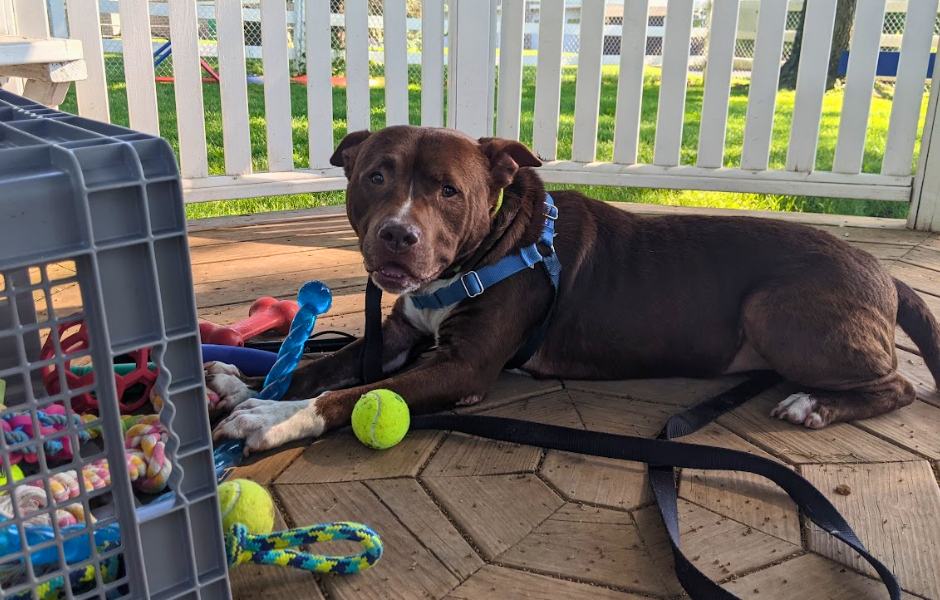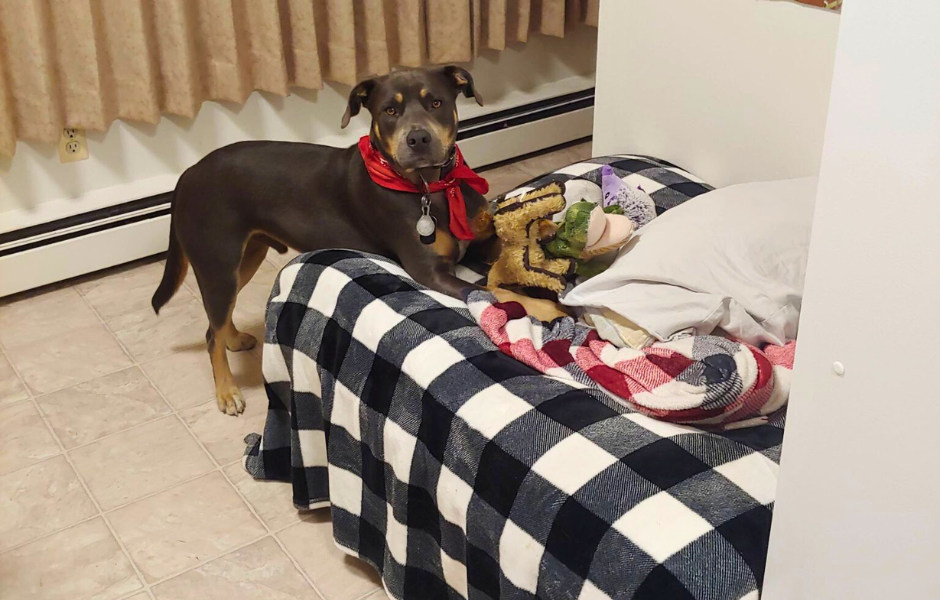June 4, 2024 –
Written by NOCO Humane’s Weld Campus Behavior Team: Kiyoka Tamesue, PSM, KPA-CTP and Julia Pinckney, MSc.
Whether you spend months scouring the websites and hallways of shelters and rescues, or fall in love while casually perusing the halls of your local humane society, you’re all set to take a new friend home! Many people are so excited to get their new companion, they forget that this is a big adjustment for the animal.
One of the more common reasons adopters return a pet to NOCO Humane is because they too quickly introduce their new companion to a whirlwind of people, other pets, activities, and action. From the pet’s perspective, that’s a lot to take in, and can lead to overstimulation and unexpected behaviors. Instead, it’s important to take your time. To help make your pet’s homecoming a smooth transition, we introduce you to the Rule of Three’s.
What is the Rule of Threes for animal adoption?
Despite its name, the “Rule of Threes” isn’t a strict rule but rather a set of easy-to-remember guidelines that act as a framework for the first three days, three weeks, and three months after you bring your animal friend home. The 3-3-3 outline can help you gain insight into what your new friend may be experiencing, guide your expectations, and give you tips on how to help everyone adjust to their new life smoothly.

First three days: decompression and safe spaces
Decompression
Bringing home a new pet is very exciting, and it is easy to accidentally overwhelm them by introducing new people, places, and activities into their lives too soon. Like humans, animals produce a stress hormone called cortisol to help manage stress, and it takes a minimum of 72 hours to return to normal levels after experiencing a major change or stressor – like arriving to a completely new environment. This gradual period of relaxation and subsequent return to “baseline” stress levels is commonly referred to as the period of decompression.
This is one of the reasons we wait at least three days before attempting a behavioral assessment with an animal in the shelter. It is important to recognize that all animals are individuals, and that decompression may take more or less time.
During these three days, allow your pet a chance to just decompress and flush out any lingering stress. When an animal is experiencing high levels of stress, their capacity to learn is diminished and their behavior may be altered. Because of this, jumping right into a training plan or lots of activities within the first few days can be a recipe for failure and frustration for both you and the animal. This is not the time to overwhelm your pet by bringing them on big outings to pet stores, dog parks, social gatherings, or having lots of friends over. If you have other pets, they need to be introduced very slowly, after the decompression period is over.
Preparing a safe space
Setting your new family member up for success begins before you even bring them home! Creating a space where they can feel safe and comfortable ahead of time is a critical step to making their adjustment period as smooth as possible. Designating a specific area or room filled with creature comforts like toys, soft bedding, and enrichment items is a great way of creating a “home base” where they can retreat if they are feeling stressed and need a break. Safe spaces should be quiet and free from excessive foot traffic and disruptive noises or movement, and all interactions should be calm and predictable to help them settle in.

Remember, you will have plenty of time in the future to explore and get to know each other. Give them some time and space to settle in and get their footing first. See blog post for more on setting up a safe space for your new animal.
First three weeks: getting into the swing of things
Once your pet has had a chance to familiarize themselves with their new family and home, they may start to feel comfortable enough to let little (or BIG) pieces of their personality shine through. Like human children, animals thrive when they are given clear boundaries and have a daily routine to follow. Now is a great time to begin establishing regular wake-up times, mealtimes, potty breaks, walks, playtime, opportunities for enrichment, bedtimes, etc. Routines don’t need to be overly strict, but having a basic daily outline provides a sense of security and calm by letting your new friend know what to expect. In the next few weeks, building trust with your new companion will be crucial, and can be achieved in many different ways: reinforcing desirable behaviors, providing daily exercise and play, paying attention to what they are trying to tell you, and giving them what they need are just a few ways to begin building a strong, lasting bond.
There are many ways to reinforce your pet aside from giving them yummy treats! Find out what motivates them – some pets like petting, tossing a ball, using a wand toy, gentle words, or even singing! – and use what is most reinforcing to help both strengthen your relationship and to encourage behaviors you like. During this period, some behavioral changes may arise. When your new pet begins to feel more comfortable with you, they may begin testing boundaries to see what does and doesn’t “work” for them in their new life. Try not to get discouraged! Behavioral changes are a perfectly normal part of the adjustment process, and we are here to help with any questions you may have. Remember that learning takes time, so continue to reward for behaviors you like so it gets reinforced.
NOCO Humane Behavior hotline: 970.226.3647 ext. 5130

First three months: home at last!
After a few months have passed, your furry (or not-so-furry) friend is likely to have settled into the daily routine and will be feeling like part of the family. Your compassion, patience, and training is paying off, and you are learning more about your pet each and every day. The foundation of trust and love you have built in the previous months has been instrumental in helping your companion feel secure and comfortable. Even if you think your pet is feeling completely at home, it is important to stick to your routine and continue to teach them new skills using positive reinforcement training. If your friend is still struggling to feel comfortable after several months, or you are finding some mismatches between your preferences and your pet’s behavior, it may be necessary to seek additional help from a professional who can provide guidance. You may also consider visiting your veterinarian to ensure your pet is physically and mentally healthy. Remember, it may take your pet more or less time to adjust, so be patient, and seek outside help if you need it.
You’ve got this!
Congratulations on expanding your family and giving an animal in need the gift of home! Enjoy cultivating your human-animal bond and exploring this wild, wild world together. Remember that all animals are individuals, and some may need more or less time to settle into their surroundings and feel safe and at ease. Let your animal take the lead and go at their pace as you provide plenty of safe spaces and regular routines to help them adjust. Change can be hard for even the most resilient of us, and kindness and compassion go a long way!





